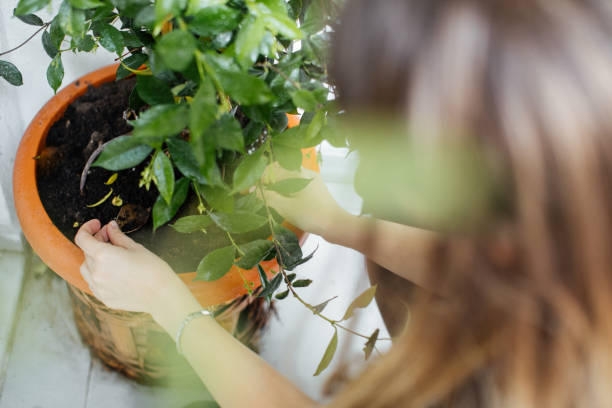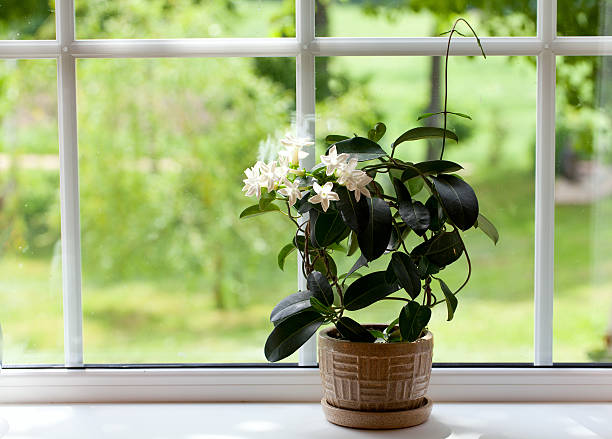How to Plant Jasmine in Pots —An Easy Guide for Beginners
Table of Contents
Things you’ll need:
To plant Jasmine in pots, you will need the following supplies:
- 1 pot at least 18 inches wide and 12 inches deep.
- 1 potting soil mix that is composed of half sand and half loam.
- 1 packet of jasmine seed.
- 1 watering can.
- 1 pair of gloves.
- 1 spade or shovel.

Instructions:
- Fill a pot halfway with soil that drains well. Growing Jasmine necessitates the use of soil that drains well. To improve drainage, fill the pot halfway with the soil by using a well-draining potting mix or adding loam-based compost to the soil. Choosing a flower pot with drainage holes is important to avoid overwatering.
- Using a shovel, dig a hole about 12 inches (30 cm) deep and fill it with water to test the soil’s drainage capacity. For well-draining soil, it should drain within 5 to 15 minutes.
- A partially shady location is ideal for the pot. If you want your Jasmine to thrive, you’ll need to keep it in the shade for several hours each day at temperatures above 60 degrees Fahrenheit (16 degrees Celsius). Place your jasmine pot in an area that gets some sunlight and gets shade. The pot should be placed near a south-facing window to be kept indoors.
- Start with a jasmine seed or seedling in the pot and grow it from there. A thin layer of soil applied should protect the seed on top of it. If you’re planting a seedling, ensure that the plant’s crown is level with the soil before planting it. Ensure that the roots are entirely covered. To aid the seedling’s adaptation to its new environment, loosen the roots with your hands as you plant them to help them grow more quickly. Planting jasmine seeds or seedlings can be obtained from most garden centers and nurseries.
- After planting the Jasmine, make sure to water it immediately. Water your plant until the water drains out of the drainage holes, using a watering can or a garden hose. Watering should be completed when the soil is damp but not soggy. Watering the flower right away will help moisten the soil and allow your plant to acclimate to its new home. To achieve the best results, mist the newly planted Jasmine with a spray bottle or watering can after it has been planted.
Tips on Taking Care of Your Jasmine in Pots

Sunlight Exposure
Place your Jasmine in a part shade spot or locate a place near a south-facing window and construct a trellis or other support.
Temperature
Indoors, Jasmine requires cool, well-circulated air to thrive. Keep the temperature between 60-75°F as much as possible.
Soil
Plant jasmine in a porous material, such as bark, peat, and other soil that drains well to ensure a healthy plant. The soil must be moist but not soggy.
Water
Water is a favorite of jasmine plants. Always keep the soil slightly moist. However, be sure not to be soggy to prevent weed growth.
Fertilizer
Using potassium and phosphorus-rich fertilizer, feed your Jasmine plants twice a year to get the best results. During the spring and summer growing seasons, liquid fertilizer can be applied to the plant every few weeks to help it grow.
Pruning
Pruning is essential for keeping Jasmine under control, especially at the start of the growing season. Keep in mind that Jasmine is a climbing vine!
Spring is the best time to repot. Make any necessary root pruning when relocating to fresh soil.
Pest and Diseases
The common Jasmine is relatively trouble-free regarding pests, diseases, and other issues. Spider mites can be a problem for winter jasmine in the spring. If this occurs, cut the plants down to the ground after they have bloomed and discard the plant material that has been infested. Feeding the crowns will help to promote new growth.
Yellowish leaves indicate the need for fertilizer, which should be applied in the early spring months. Keep an eye out for mealybugs in your houseplants (white, cottony masses under leaves and on stems). Use a cotton swab dipped in rubbing alcohol to get rid of it.
